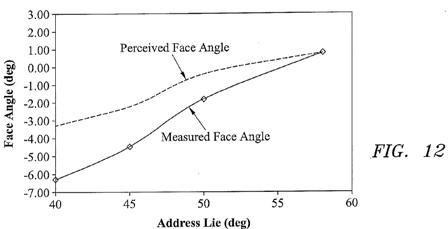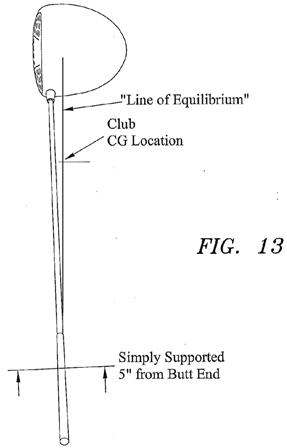How Do You Perceive Your Face Angle?
Callaway is looking to change the way you perceive your club’s face angle. One of their recently published patent applications provides a great education on how a golfer perceives a golf club’s face angle. The application published as US Pub. No.
[0017] As a driver is rotated thru a range of address lie angles the measured face angle will generally change by an amount related to the loft of the face at initial orientation and the range of lie angles rotated thru. For instance, a driver having a 10 degrees loft and 0 degree face angle (also known as “Square”) at a design lie angle of 56 degrees, will have a measured face angle that changes significantly (see FIG. 11) as address lie angle changes from 56 degrees to 40 degrees. This change in measured face angle is generally not perceived by the golfer as it doesn’t result in rotation of the club head about a vertical axis. This behavior is widely considered desirable as it provides a consistent “looking” club at address for a wide range of players who may have different lie angles at address.

[0018] However, depending on the relative orientation of the club center of gravity (“CG”) and the sole surface in the vicinity of contact with the ground, the measured and perceived face angles may vary unexpectedly at different address lie angles. This is a problem with many current woods which can result in problems with acceptance in the market place. Some golfers won’t even try a club that has a face angle they consider unappealing, regardless of the performance of the club. An example of the face angle behavior of such a club is shown in FIG. 12.
[0019] It is apparent that the need exists for a golf club head with a stable face angle. Golfers want a golf club with an appealing face angle while golf equipment manufacturers need to provide as much standardization as possible in order to prevent escalation of manufacturing costs. Therefore, although prior art has presented many inventions for providing customization, the prior art has failed to provide a cost effective method for customization.
BRIEF SUMMARY OF THE INVENTION
[0020] The present invention seeks to overcome the variability and uncertainty of face angle at address (natural sole) for a wood having a single keel point. Further, the club head design seeks to provide the intended perceived face angle regardless of the lie angle at which the player addresses the club, within a range of 40-55 degrees.
[0021] The present invention allows for a golf club head with a keel zone that affects the appearance of the face angle of the golf club. For example, the golf club has a measured face angle that changes significantly as lie angles change from 40 degrees to 60 degrees. However, because of the keel zone, the measured face angle is not perceived by the golfer as there is no rotation of the club head.
[0022] One aspect of the present invention is a golf club head. The golf club head includes a body and a keel zone. The body has a front portion, a crown portion and a sole portion. The body also has a heel end, a toe end and an aft end. The sole portion has a single keel point. The keel zone is located in the sole portion. The keel zone is located in the fore-aft direction by the equilibrium line. The keel zone is located in the heel-toe direction by the target lie angle. The keel zone preferably has a width of 0.50 inch in the fore-aft direction and 1.00 inch in the heel-toe direction.
[0023] Another aspect of the present invention is a golf club. The golf club includes a golf club head, a keel zone and a shaft. The golf club head includes a body having a front portion, a crown portion and a sole portion. The body also has a heel end, a toe end and an aft end. The sole portion has a single keel point. The keel zone is located in the fore-aft direction by the equilibrium line. The keel zone is located in the heel-toe direction by the target lie angle. The size of the keel zone is preferably 0.5 inch wide in the fore-aft direction and 1.0 inch wide in the heel-toe direction. The shaft is connected to the golf club head. The equilibrium line is defined as a line that runs from a point on the underside of the grip five inches below the butt end of the shaft through the club center of gravity and extending through the club head.
.
.
.
[0042] As shown in FIG. 9, a survey of competitor drivers exhibit the undesirable behavior of excessive variation in face angle at different address lie angles.
.
.
.
[0044] The “line of equilibrium” is preferably defined as a line that runs from a point on the underside of the grip at five inches below the butt end thru the club center of gravity and extending thru the head. The keel zone is defined relative to this line.
.
.
.

[0048] As shown in FIG. 13, the golf club has an equilibrium line which runs from a point on the underside of the grip at five inches below the butt end through the club center of gravity and extending through the head. The sole surface, within a defined proximity of the sole keel point, is such that even if the club is addressed at different lie angles, between 40-60 degrees, the resulting perceived face angle will be constant within +/-0.5 degrees.
I suppose this is why you should address the ball at the correct lie angle.
Dave Dawsey – Keeping an Eye on Innovative Golf Products
PS – check out some interesting golf tee inventions here
